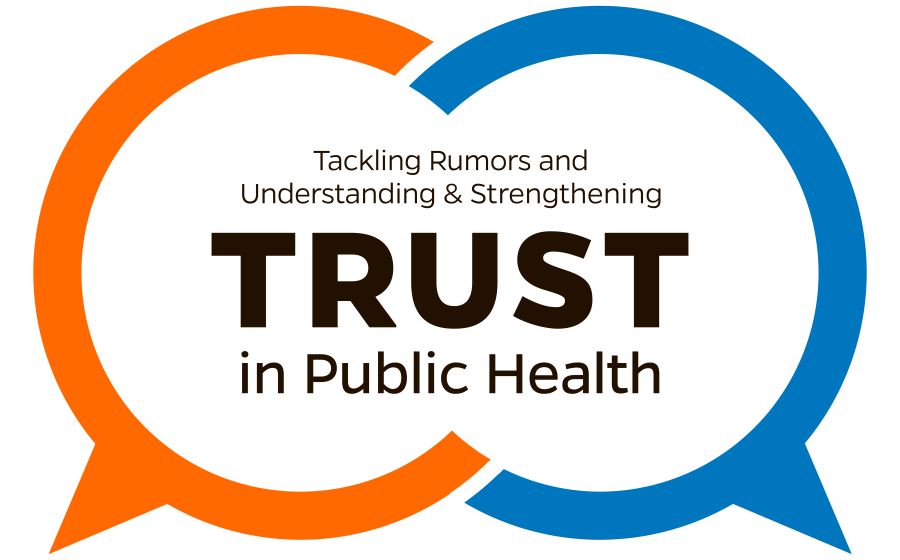
Conceptual framework guiding this project
The TRUST in Public Health project team created an evidence-informed conceptual framework to describe how different components of the project connect with each other. These components are: (1) trust in emergency preparedness and response (PHEPR), (2) the spread of misinformation, (3) approaches to counter misinformation, and (4) efforts to build trust. Each component was developed based on data collected and analyzed throughout the course of the project.
What is the conceptual framework?

This framework uses the metaphor of liquid in a tank to think about trust in PHEPR. The amount of liquid in the tank—that is, the level of public trust in PHEPR—can rise or fall based on various factors. One of these factors is the spread of misinformation, which decreases trust in PHEPR. However, approaches to counter misinformation can reduce the spread of misinformation and, therefore, improve trust in PHEPR over time. Also affecting the level of trust in PHEPR are efforts to build trust, which directly and indirectly increase the level of trust.
What does each component of the framework represent?

A: Visualize the level of public trust in PHEPR as water in a tank—a “trust tank.” Many factors can affect whether the level of trust in the “trust tank” rises or falls. Some factors can add more trust into the “trust tank” and increase its level, while other factors could decrease its level by opening the valve at the bottom and causing trust to drain into a sink.
B: Misinformation often spreads during public health emergencies (PHEs) and certain kinds of rumors seemed to emerge repeatedly during several past PHEs. The TRUST in Public Health team identified 11 types of rumors that arise repeatedly during PHEs. They fall into 3 overarching and overlapping categories—cognition, culture, communication—or into the intersections of these categories. Learn more about common rumors that emerge during public health emergencies.
C: The spread of misinformation can open the valve at the bottom of the “trust tank” and decrease the level of trust in PHEPR. Likewise, low levels of trust in public health increase the spread of misinformation.
D: There are several promising approaches to manage and counter misinformation. These approaches tend to act on the information, individual, interpersonal, or institutional levels. Learn more about approaches to manage and counter misinformation and disinformation.
E: Approaches to manage and counter misinformation are helpful for proactively and reactively reducing the spread of misinformation.
F: There are many efforts and activities that practitioners use to build trust in PHEPR. Among them, the TRUST in Public Health team recommends 5 evidence-informed activities that can build practitioners’ capacity to strengthen public trust before, during, and after PHEs. Learn more about the checklist to build trust, improve public health communication, and anticipate misinformation during PHEs.
G: Approaches to manage and counter misinformation often aim to build trust over the long term and support the implementation of trust-building activities. Trust-building activities, like approaches to manage and counter misinformation, can act on information, individual, interpersonal, and institutional levels.
H: Most trust-building activities directly fill the “trust tank” and increase levels of public trust in PHEPR.
I: Many trust-building activities can intercept the process by which the spread of misinformation reduces trust in PHEPR and vice versa. This process strengthens the public’s resilience to health misinformation.
J: Over time, trust-building activities strengthen public health capacities and promote recovery from systemic loss of trust in PHEPR. This recovery process also fills the “trust tank” and increases levels of trust in PHEPR.
How did we create the conceptual framework?
The TRUST in Public Health team identified linkages between different data collection efforts undertaken to establish the evidence base for this project. This includes:
- A thematic analysis of rumors that emerge repeatedly during PHEs.
- An analysis of approaches used to respond to, manage, and counter misinformation.
- A mapping exercise to assess how approaches used to manage and counter misinformation could be leveraged to respond to each type of rumor.
- Key informant interviews and focus group discussions with public health professionals and communicators to understand strategies to build trust, improve public health communication, and anticipate misinformation during public health emergencies.
- A participatory diagramming process to create a conceptual framework for predicting and responding to future misinformation that also illustrates the flow of logic between core components of this project: trust in public health systems, rumors and misinformation, approaches to manage and respond to misinformation, and capabilities to strengthen trust in PHEPR.

